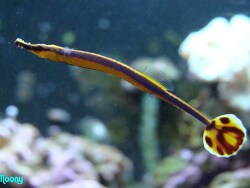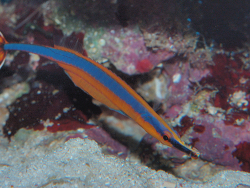Info
Doryrhamphus excisus excisus is one of the pipefish species that is somewhat easier to acclimatize to replacement fry than many other pipefish.
At least in most cases, a quicker intake is achieved here.
If the animals refuse, you should of course try live food (Artemia, Mysis and copepods e.g. Tigriopus californicus or Tisbe).
In any case, feed a lot and generously so that the animals are quickly fit again.
Like almost all fish, they are often weakened after the lengthy import process.
Sex and mating
As males and females can be distinguished by the bridge of the nose, mating is possible and should be practiced. The male has small bumps on the bridge of the nose, which can be recognized from a size of approx. 4 cm.
But never put two males or two females together, they will chase/fight each other until the weaker animal dies.
As a general rule, these animals should not be kept in a tank with lots of large and fast-eating fish, as they are rather slow and cautious eaters.
Caution - keeping with other pipefishes
Do not keep together with Doryrhamphus janssi. The small blue-striped pipefish is the aggressor and the janssi will be attacked.
In Dunckerocampus pessuliferus the Sulu pipefish tries to eat the eggs out of the pregnant blue-striped male or disturbs them.
Feeding intake.
The fish take a long time to eat at the beginning, before the food is taken up, a close inspection is carried out. After acclimatisation, the offered frozen food is eaten without problems. It should be noted that wild-caught fish behave differently than offspring when it comes to food intake. In the case of offspring, the size of the fish purchased also plays a role in the choice of food.
Breeding information:
Young male pipefish need some time or mating before they carry the attached eggs to maturity.
The spawning interval* is approx. 3 - 4 days; the size of the attached eggs** indicates when the young pipefish will hatch.
* The water temperature influences the spawning period (with a difference of 1°C, for example, the difference can be ± 1 day) and, in the case of gonochoristic (separate-sex) fish or shrimps, the sex. If the temperature is below the usual regional temperature, mainly female larvae will hatch from the clutch, above this temperature mainly male larvae will hatch. Furthermore, the aquarium conditions (e.g. light duration, density) can also influence the sex.
** The spawning size or the number of larvae depends on several factors - age and condition of the parent animals, water conditions, food quality, stress factors and the dissolved oxygen content.
Breeding information:
The hatched pipefish are approx. 2 - 5 mm in size. Various types of copepods are suitable as initial food: Tisbe biminensis and Apocyclops panamensis and Nitokra lacustris. After 5 - 7 days, enriched Artemia pupae can then be fed.
Caution Too many bottom-dwelling copepods will disturb the sleeping pipefish. Too many copepods can also kill the pipefish.
Tip: Suck up the large copepods when cleaning and offer them again as food when the pipefish are larger. From 2 - 3 cm, Tigriopus californicus can also be offered in small numbers.
Some retailers offer a similar-looking pipefish called Doryrhamphus melanopleura (Bleeker, 1858).
However, this name is not officially accepted, they are ultimately the same species.
Synonyms:
Doryhamphus excises
Doryhamphus excises excises Kaup, 1856
Doryichthys californiensis (Gill, 1862)
Doryichthys excisus (Kaup, 1856)
Doryichthys melanopleura (Bleeker, 1858)
Doryichthys pleurotaenia Günther, 1880
Doryramphus excisus (Kaup, 1856)
Doryrhamhus melanopleura (Bleeker)
Doryrhamphus californiensis Gill, 1862
Doryrhamphus excisus Kaup, 1856 ·
Doryrhamphus melanopleura (Bleeker, 1858)
Doryrhamphus melanopleura cooki Weed & Woods, 1953
Doryrhamphus melanopleura melanopleura (Bleeker, 1858)
Doryrhamphus melanopleura pleurotaenia (Günther, 1880)
Doryrhamphus pleurotaenia (Günther, 1880)
Microphis extensus Snyder, 1911
Microphis mayottae Fourmanoir, 1955
Microphis melanopleura (Bleeker, 1858)
Microphis pleurotaenia (Günther, 1880)
Syngnathus melanopleura Bleeker, 1858







 Keith DP Wilson, UK
Keith DP Wilson, UK






















